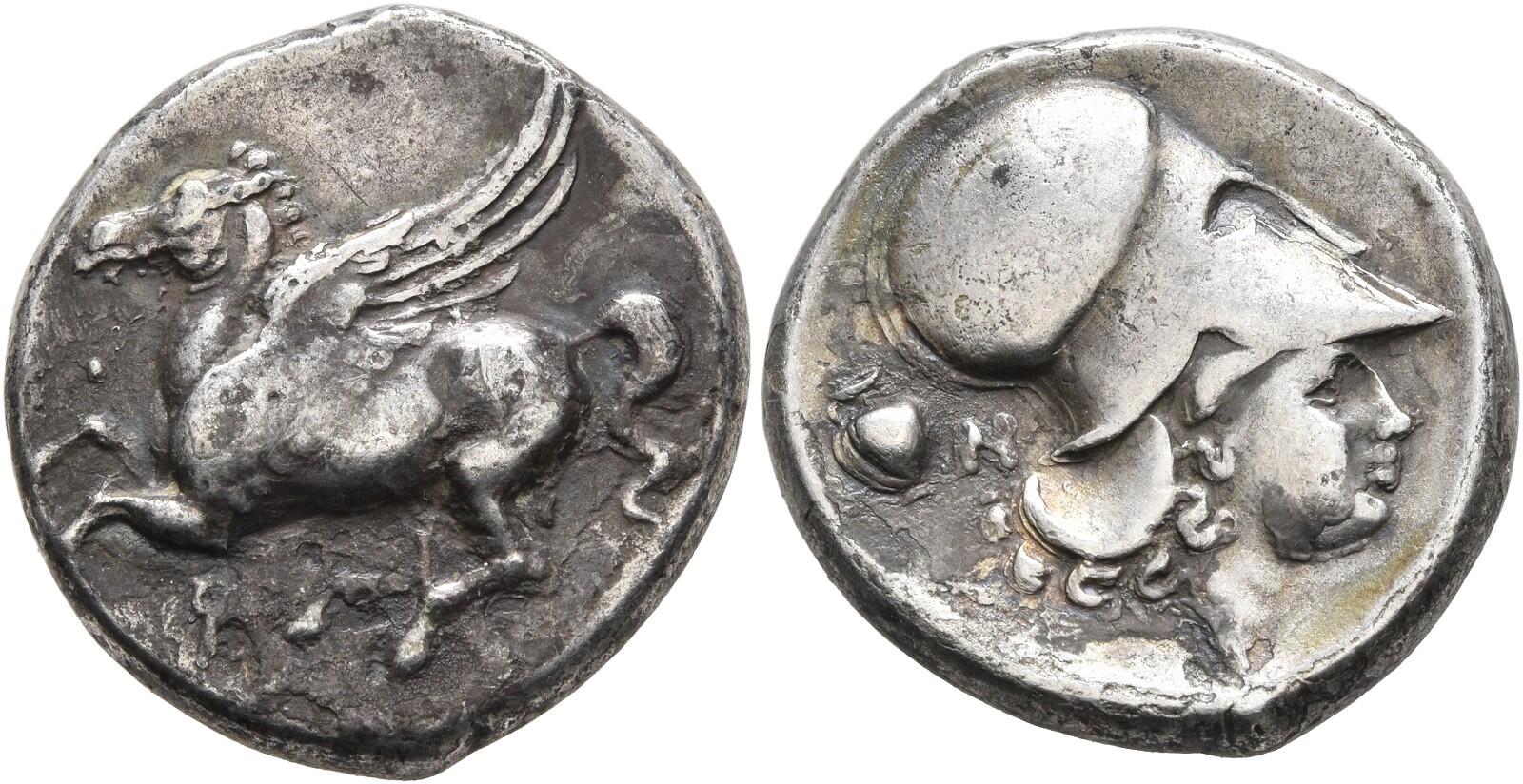340 BCE - 325 BCE | TAPAΣ
Overstriking coin
SO 1364 - Taras over uncertain mint.jpg
[1]
Overstruck variety
Taras on Corinth - Heritage, 3037, 4 Jan. 2015, 29885 overstruck variety.jpg
[2]
|
|
Sale(s)Sale(s) ᵖ:
|
Heritage World Coin Auctions, NYINC Signature Sale 3037, 4 Jan. 2015, 29885
|
| Private collection(s)Private collection(s) ᵖ:
|
The California Collection
|
|
Description
| ObverseInscription or printing placed on the obverse.:
|
Youth seated on a horse right, restrained at neck by groom. Above, Nike crowning th youth. Beneath horse, Z.
|
ReverseInscription or printing placed on the reverse.:
|
TAPAΣ (Greek) Male character (Taras or Phalanthos), nude, seated on a dolphin to left, holding cantharos. In right field, K.
|
Mint and issuing power
| MintIdentifies the place of manufacture or issue of a numismatic object.:
|
Taras
|
Ancient regionAncient region.
|
Calabria
|
Modern countryModern country: Italy
|
AuthorityIdentifies the issuing power. The authority can be "pretended" when the name or the portrait of X is on the coin but he/she was not the issuing power. It can also be "uncertain" when there is no mention of X on the coin but he/she was the issuing power according to the historical sources:
|
|
Chronology
| FromIdentifies the initial date in a range assigned in a numismatic context. 340 BCE toIdentifies the final date in a range assigned in a numismatic context.. 325 BCE
|
Classical 480-323 BC  periodTime period of the numismatic object. periodTime period of the numismatic object.
|
Physical description
MetalThe physical material (usually metal) from which an object is made.: Silver 
|
WeightWeight of the numismatic object (in grams). in grams: 7.837.83 g <br />7,830 mg <br />
|
DenominationTerm indicating the value of a numismatic object. Examples: tetradrachm, chalkous, denarius.: nomos
|
AxisDescribes the directional relationship between the obverse and reverse of a numismatic object.: 44 mm <br />0.4 cm <br />
|
| DiameterDescribes diameter of an object (in mm).: 2222 mm <br />2.2 cm <br />
|
|
References
Description
| ObverseInscription or printing placed on the obverse.:
|
Pegasos flying left, below, Ϙ
|
ReverseInscription or printing placed on the reverse.:
|
Head of Athena to right, wearing Corinthian helmet
|
Mint and issuing power
| MintIdentifies the place of manufacture or issue of a numismatic object. ᵖ:
|
Corinth
|
Ancient regionAncient region. ᵖ
|
Peloponnesus
|
Modern countryModern country: Greece
|
AuthorityIdentifies the authority in whose name (explicitly or implicitly) a numismatic object was issued. ᵖ:
|
|
Chronology
| FromIdentifies the initial date in a range assigned in a numismatic context. 375 BCE toIdentifies the final date in a range assigned in a numismatic context.. 330 BCE
|
Classical 480-323 BC  periodTime period of the numismatic object. periodTime period of the numismatic object.
|
Physical description
| DenominationTerm indicating the value of a numismatic object. Examples: tetradrachm, chalkous, denarius. ᵖ:
|
stater 
|
|
|
References
References
- ^ Ravel, Oscar E. (1990), Descriptive catalogue of the collection of Tarentine coins formed by M. P. Vlasto, London, Spink
- ^ Fischer-Bossert, Wolfgang (1999), Chronologie der Didrachmenprägung von Tarent, 510-280 v. Chr., Berlin, De Gruyter, xvii, 495 p., [84] pl.
- ^ Rutter N. Keith et alii (eds.) (2001), Historia Numorum Italy, London, xvi, 223 p., 43 pl.
- ^ Hoover, Oliver D. (2018), The Handbook of Greek Coinage Series, Volume 1. Handbook of Coins of Italy and Magna Graecia, Sixth to First Centuries BC., Lancaster-London, 2018, lxi, 527 pages, 23 cm
- ^ Calciati, Romolo (1990), Pegasi, Mortara, Edizioni I.P..

